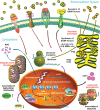Targeting senescent cells for a healthier longevity: the roadmap for an era of global aging
- PMID: 36699942
- PMCID: PMC9869767
- DOI: 10.1093/lifemedi/lnac030
Targeting senescent cells for a healthier longevity: the roadmap for an era of global aging
Abstract
Aging is a natural but relentless process of physiological decline, leading to physical frailty, reduced ability to respond to physical stresses (resilience) and, ultimately, organismal death. Cellular senescence, a self-defensive mechanism activated in response to intrinsic stimuli and/or exogenous stress, is one of the central hallmarks of aging. Senescent cells cease to proliferate, while remaining metabolically active and secreting numerous extracellular factors, a feature known as the senescence-associated secretory phenotype. Senescence is physiologically important for embryonic development, tissue repair, and wound healing, and prevents carcinogenesis. However, chronic accumulation of persisting senescent cells contributes to a host of pathologies including age-related morbidities. By paracrine and endocrine mechanisms, senescent cells can induce inflammation locally and systemically, thereby causing tissue dysfunction, and organ degeneration. Agents including those targeting damaging components of the senescence-associated secretory phenotype or inducing apoptosis of senescent cells exhibit remarkable benefits in both preclinical models and early clinical trials for geriatric conditions. Here we summarize features of senescent cells and outline strategies holding the potential to be developed as clinical interventions. In the long run, there is an increasing demand for safe, effective, and clinically translatable senotherapeutics to address healthcare needs in current settings of global aging.
Keywords: aging; clinical trial; senescence-associated secretory phenotype; senescent cell; senotherapeutics.
© The Author(s) 2022. Published by Oxford University Press on behalf of Higher Education Press.
Conflict of interest statement
J.L.K. has a financial interest related to this research including patents and pending patents covering senolytic drugs and their uses that are held by Mayo Clinic. This research has been reviewed by the Mayo Clinic Conflict of Interest Review Board and was conducted in compliance with Mayo Clinic conflict of interest policies. The other authors declare no conflict of interest.
Figures



References
Publication types
Grants and funding
LinkOut - more resources
Full Text Sources
